Mass Teaching Resources
Teach students how to measure mass or calculate the mass of an object and more with games, worksheets and more teacher-created resources for your classroom!
Aligned with both TEKS and Common Core math, each printable and digital teacher resource in this collection has undergone careful review by our math teachers to ensure it's ready to be added to a mass lesson plan.
Is this your first year teaching kids how to find the mass of an obect? Or maybe you're just looking for fresh ways to engage your students on the topic? Read on for a primer from our teacher team, including a kid-friendly definition of mass in physics, the formula for calculating mass and more!
What Is Mass? A Kid-Friendly Definition
Do you need a mass definition to start your lesson? This word can be difficult for kids to understand due to its intangible nature. While we can measure the length or width of an object with a ruler, finding mass means dealing with an invisible concept.
So how do you explain it? Here's a definition that our teacher team likes to use to describe mass for our own students:
Mass is a measurement of how much matter an object is made of.
Mass vs. Weight — What's the Difference?
The definition above builds off students' study of matter in science classes and what they've learned about "heavy" and "light" objects and the differences between them both.
But as we've already noted, mass can be confusing for kids, and one of the most common points of confusion comes down to weight. After all, if something is heavy, it has more mass than a light object, but it also has more weight.
So, are mass and weight the same thing? No! Let's break down the differences:
Mass |
Weight |
| A measurement of the amount of matter in an object | A measurement of the force exerted on an object due to gravity |
| Doesn't change even when the amount of gravitational force on the object changes | Changes depending on the amount of gravitational force on the object |
What Is Mass Measured In? A Look at Units of Mass
While many measurements in the United States involve units from the United States customary system — also known as the imperial system — mass is measured in units from the metric system!
The most common units for mass are kilograms (abbreviated kg) and grams (abbreviated g).
This represents another difference between calculating the mass of an object and measuring its weight! Weight is typically measured in pounds, ounces and tons here in the US.
How to Find Mass — 4 Methods
We've covered what mass is and how it's measured. Now it's time to find the mass of different objects!
There are four common methods that can be used to calculate mass, and each one has its own applications. Read on for a breakdown of each one, including a formula that students can use to measure mass.
1. Measuring Mass With a Balance Scale
The simplest way to measure the mass of an object is to use a balance scale. Students can place the object on the scale and read the result.
Pretty simple, huh?

2. Using a Formula to Find Mass
What if the object is too large to place on a scale, or you don't have the object ... or a scale? Using a formula to find the mass of an object is another option in these situations!
There are two mass formulas that are typically used to calculate mass:
Density Formula
If you know the density (mass per unit volume) of a material and the volume of the object, you can use the following formula:
Mass=Density×Volume
Weight Formula
Although weight and mass are different, here on Earth these two measurements are in proportion to one another. Because of this, you can make use of the weight formula to solve for mass.
Weight=Mass×Acceleration due to Gravity
Note: This formula only works when the object is in a gravitational field!
3. Measuring Mass With the Water Displacement Method
Do you have an irregularly shaped object? The simplest way to calculate its mass is to use the water displacement method.
- Submerge the object in water.
- Calculate the volume of water displaced. This is equal to the volume of the object.
- Calculate the mass using the density formula mentioned earlier.
4. Using a Spring Scale to Calculate Mass
The final method for finding the mass of an object is to use a spring scale. This is typically a method taught in high school rather than elementary school.
The spring scale is used to measure the force exerted by an object due to gravity, with students employing Newton's second law to find the mass of a particular object.
- Plus Plan
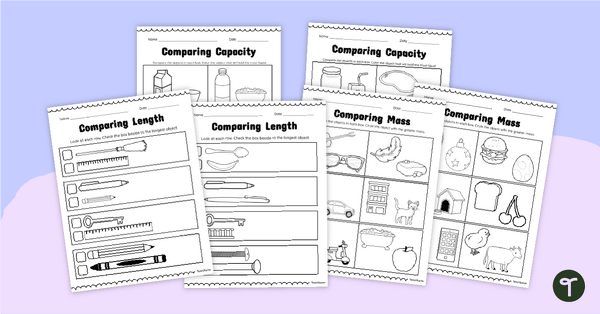
Kindergarten Measurement Worksheets - Comparing Length, Mass, & Capacity
Practice comparing units of mass, capacity, and length with a printable pack of kindergarten measurement worksheets.
- Free Plan
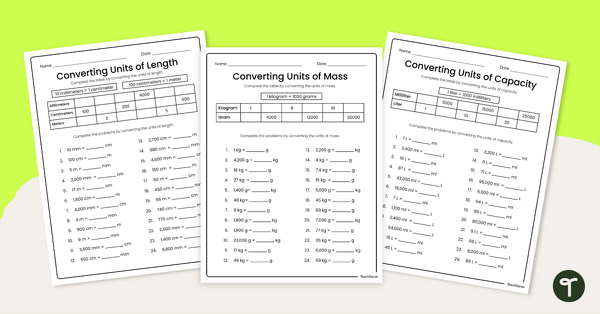
Metric Conversion Worksheet Set
Utilize our metric conversion worksheet set to give your students practice converting units of metric length, mass, and capacity.
- Plus Plan
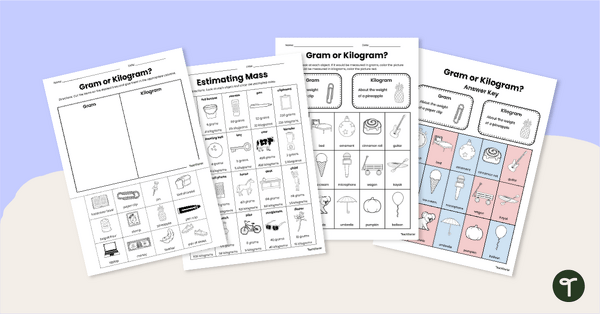
All About Mass Worksheet Pack
Practice metric units used to measure the mass of objects with this set of worksheets.
- Plus Plan
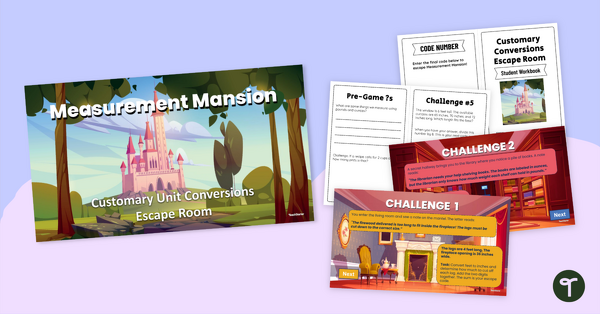
Measurement Escape Room (Customary System)
“Escape” the ordinary in your classroom with this measurement escape room that will engage your students while they practice customary conversions of length, weight, and capacity.
- Plus Plan
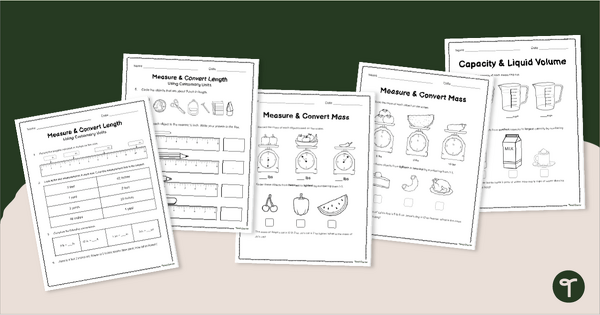
Measurement Worksheets - 3rd & 4th Grade
Practice measuring length, volume, capacity, time, and more with a printable pack of 3rd grade measurement worksheets.
- Plus Plan
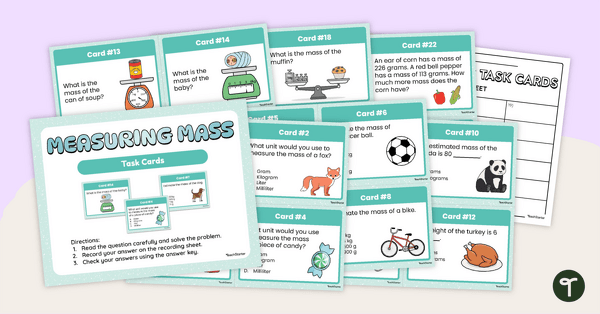
Measuring Mass Task Cards
Explore estimation and measuring mass with this set of 24 word problem task cards.
- Plus Plan
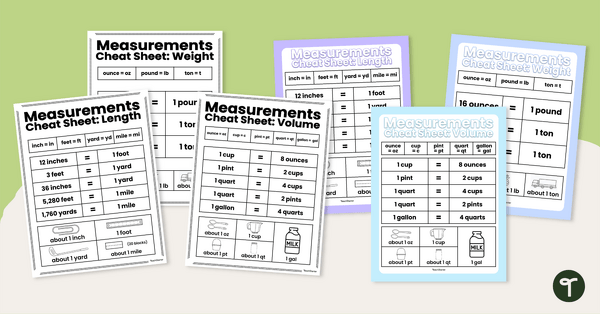
Customary Measurement Conversion Chart Set
Use this customary measurement conversion chart pack as a handout or classroom poster for easy reference!
- Plus Plan
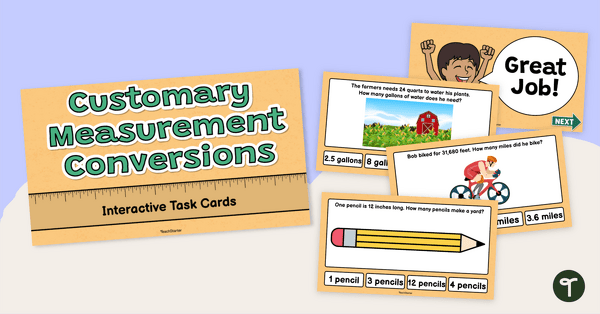
Interactive Customary Conversion Activities — Interactive Task Cards
Gamify learning with interactive customary conversion activities like these engaging digital task cards!
- Plus Plan
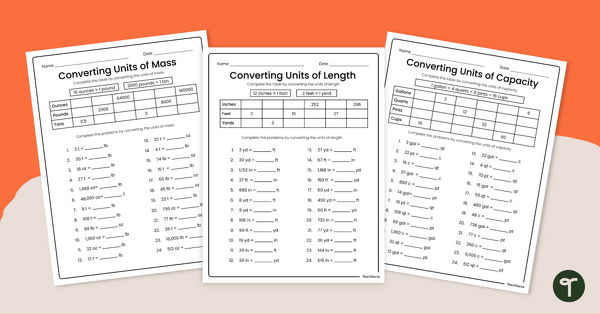
Customary Measurement Conversion Worksheets
Download our customary measurement conversion worksheets to give your students the practice they need to master converting customary units of length, mass, and capacity.
- Plus Plan
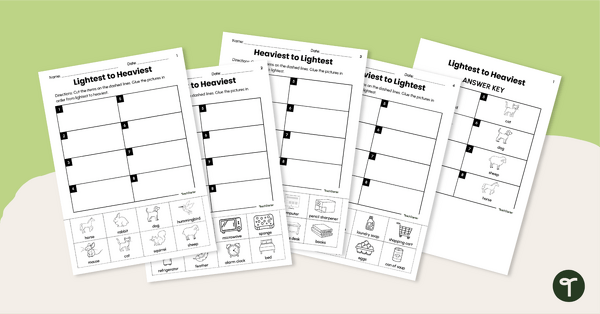
Ordering Mass Cut and Paste Worksheets
Assist students in their knowledge of simple mass with these heaviest to lightest cut-and-paste worksheets.
- Plus Plan
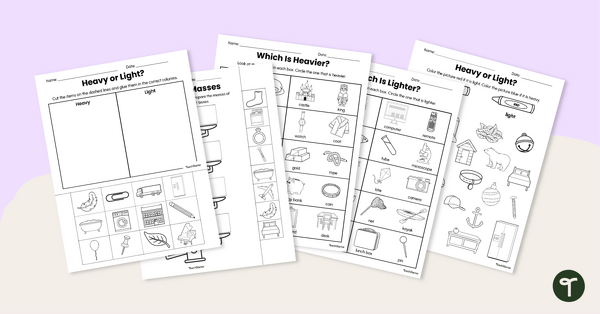
Heavy and Light Worksheet Pack
Practice knowledge of heavy and light with this set of cut-and-paste worksheets.
- Plus Plan
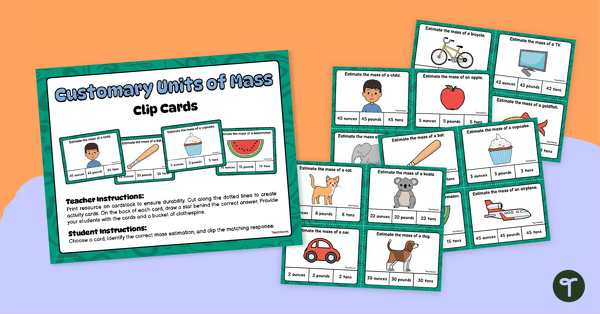
Customary Units of Mass Clip Cards
Estimate the mass of each object shown on this set of customary units of mass clip cards.
- Plus Plan
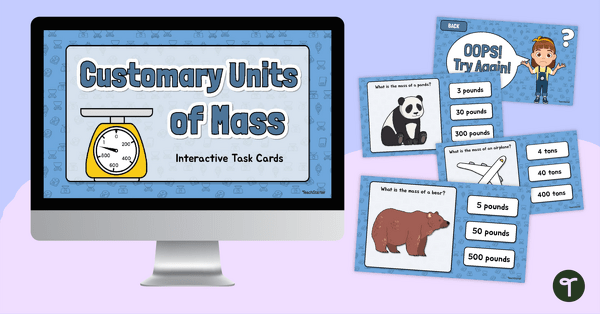
Customary Units of Mass Interactive Task Cards
Explore different customary units of mass with this set of interactive digital task cards.
- Free Plan
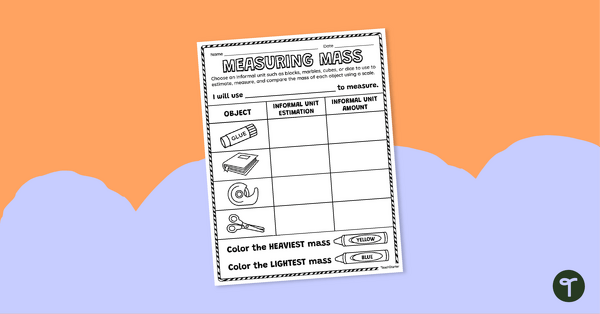
Measuring Informal Mass Worksheet
Practice measuring items using informal units of measurement with this measuring mass worksheet.
- Plus Plan
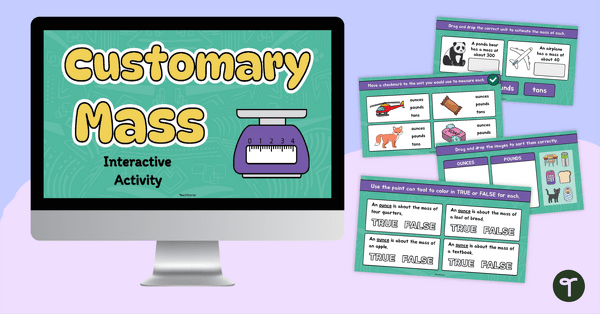
Customary Units Mass Measuring Interactive Activity
Practice the different customer units of mass with this engaging interactive activity.
- Plus Plan
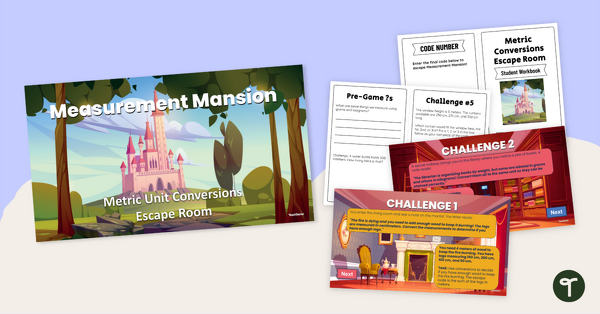
Metric Conversion Games — "Measurement Mansion"
“Escape” the ordinary in your classroom with metric conversion games like our “Measurement Mansion” escape room.
- Plus Plan
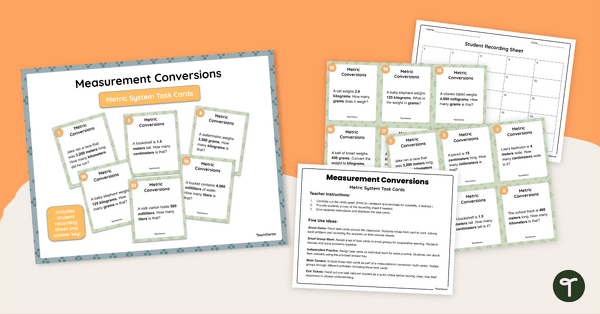
Measurement Conversion Activities - Metric System Task Cards
Share these measurement conversion activities task cards with your students to help them master metric conversions of length, mass, and capacity.
- Plus Plan

Measurement Conversion Games — Customary System Task Card Set
Download our measurement conversion games task card set to give your students many ways to practice converting between customary units of length, weight, and capacity.
- Plus Plan

Metric Conversion Word Problems Worksheet Set
Assign our metric conversion word problems worksheet set to strengthen your students’ understanding of metric conversions.
- Plus Plan
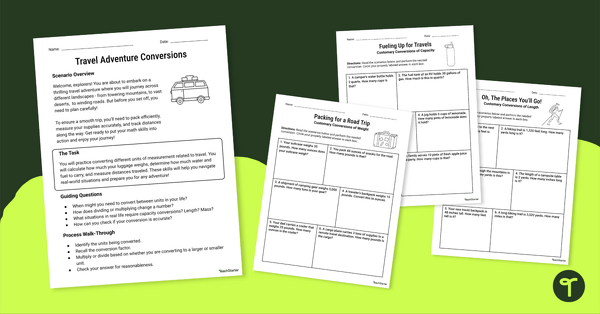
Customary Measurement Conversion Word Problems Worksheet Set
Use our customary measurement conversion word problems worksheet set to strengthen your students’ understanding of customary conversions.
- Plus Plan

Converting Customary Units of Weight Worksheets
Share these converting customary units of weight worksheets with your students to give them the practice they need to master conversions of customary weight.
- Plus Plan

Converting Mass Units Worksheet Set
Download this converting mass units worksheet set to give your students the practice they need to master conversions of metric mass.
- Plus Plan
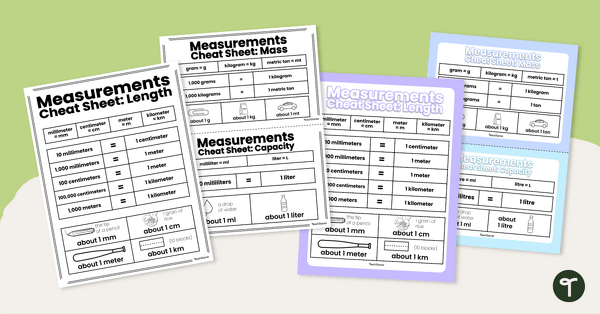
Metric Conversion Handout Set
Use this metric conversion handout set as a personal student guide or classroom poster for easy reference!
- Plus Plan

Metric Conversion Practice Worksheet Set — "Riddle Me!"
Laugh and learn with our metric conversion practice worksheet set that will give your students practice converting metric units of length, capacity, and mass.
- Plus Plan
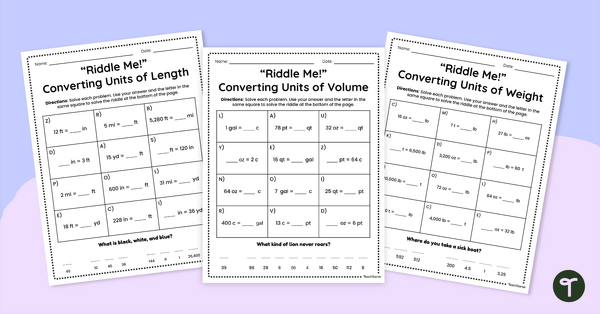
Customary Measurement Conversion Worksheet Set — “Riddle Me!”
Share this customary measurement conversion worksheet set with your students and watch them laugh while learning to convert customary units of length, weight, and volume!
- Plus Plan
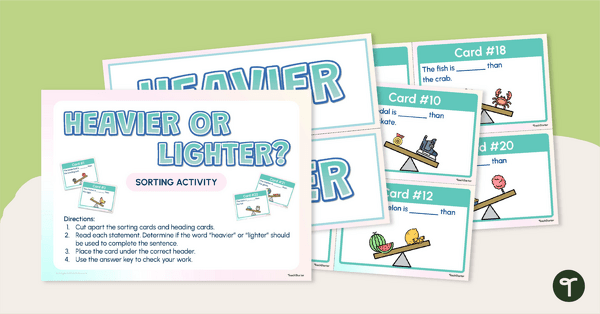
Heavier or Lighter? Sorting Activity
Sort cards into heavier and lighter headings after looking at the balance scales on each card with this mass sorting activity.
- Plus Plan
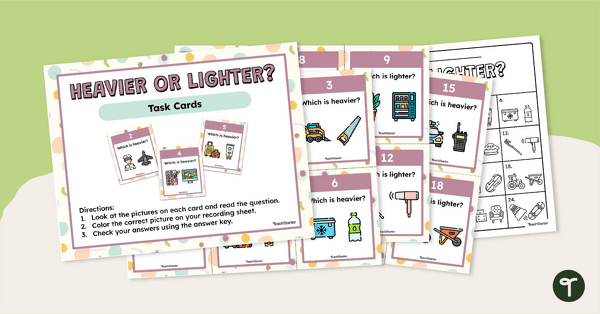
Heavier or Lighter Task Cards
Compare and contrast pairs of objects and encourage students to respond to questions featured on this set of task cards.
- Plus Plan
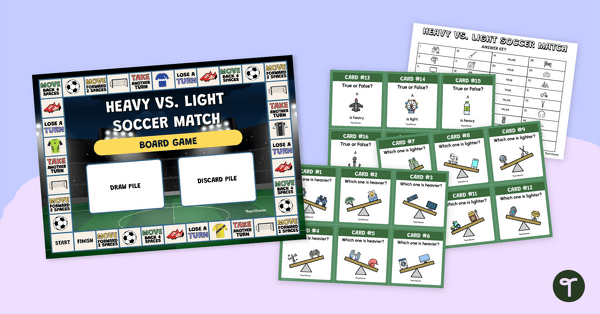
Heavy vs. Light Soccer Match Board Game
Explore comparing the mass of objects with this fun and engaging weight game board for the classroom.
- Plus Plan
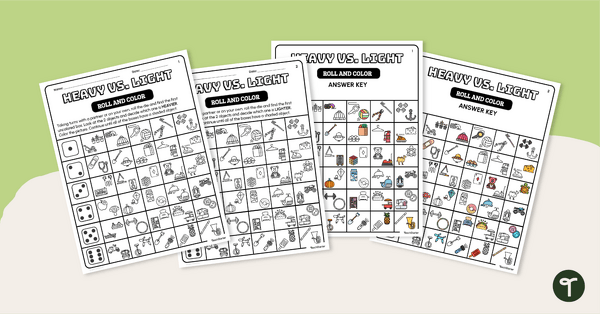
Heavy vs. Light Roll and Color Activity
Explore items and decide which is heaviest and lightest in this fun and engaging roll and color activity.
- Plus Plan
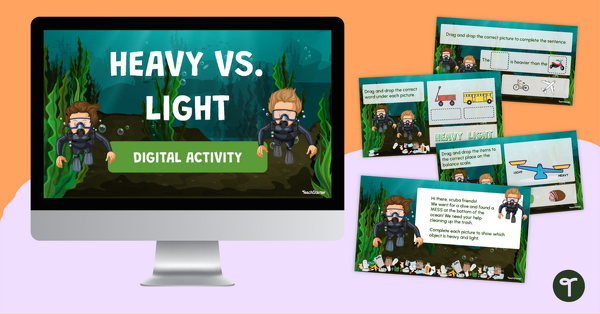
Heavy vs. Light Digital Activity
Explore the mass of items and compare and contrast the heaviest and lightest with this set of 25 digital task cards.
- Free Plan

Informal Mass Scavenger Hunt Worksheets
Practice using balance scales to determine the weight of objects using informal units with these fun scavenger hunt worksheets.
- Plus Plan
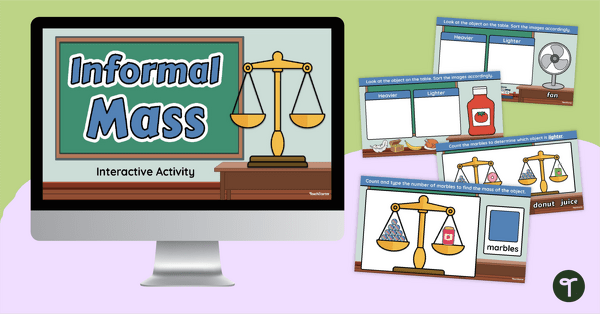
Informal Mass - Heavier or Lighter Interactive
Practice using informal units of measurement to compare and estimate the mass of everyday objects with this engaging digital activity.